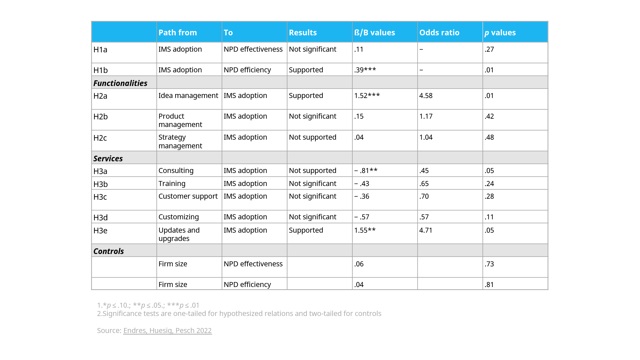
GUEST POST from Jesse Nieminen
Our industry of innovation management software is quite an interesting one. It’s been around for a while, but it’s still not a mainstay that every organization would use, at least not in the same way as CRM and team communication software are.
Hence, there’s quite little independent research available out there to prove its efficacy, or even for determining which parts of it are the most valuable.
So, when I saw a new study, conducted jointly by a few German universities, come out on the topic, I was naturally curious to learn more.
In this article, I’ll share the key findings of the study with you, as well as some personal thoughts on the how and why behind these findings. We’ll also wrap up the discussion by considering how these findings relate to the wider trends within innovation management.
About the Study
Before we get to the results, let’s first briefly cover what the study was actually about and how it was conducted.
First, the focus of the study was to analyze the role of Innovation Management Software (IMS) adoption for New Product Development (NPD) effectiveness and efficiency, as well as the factors (software functionality and offered services) that actually led to successful adoption of said innovation management software.
The data was collected with an online questionnaire that was answered by innovation managers from 199 German firms of varying sizes, 45% of which used an Innovation Management Software, and 55% of which didn’t.
While this is the largest independent piece of research I’ve yet seen on innovation management software, we should remember that all research comes with certain limitations and caveats, and it’s important to understand and keep these in mind.
You can read the paper for a more detailed list, but in my opinion, this boils down to a few key things:
- First, the study uses NPD performance as a proxy for innovation outcomes. This is an understandable choice to make the research practical, but in reality, innovation is much more than just NPD.
- Second, while the sample size of companies is respectable, the demographic is quite homogenous as they are all German companies that employ an innovation manager, which obviously isn’t representative of every organization out there.
- Third, the results are analyzed with regression analyses, which always brings up the age-old dilemma: correlation doesn’t imply causation. In other words, the study can tell us the “what”, not the “why” or “how”.
- And finally, while the chosen variables are based on validated prior research, the questions still require subjective analysis from the respondent, which can introduce some bias to the results.
So, let’s keep these in mind and move on to the actual findings.
The Main Findings of the Study
The authors have done a great job in summarizing the hypothesis and respective results in a table, which you’ll also find reproduced below.

Let’s break the results down by hypothesis and cover the main takeaways for each.
Innovation Management Software Adoption Leads to Better NPD Performance
The first hypothesis was that using an Innovation Management Software would lead to better New Product Development performance. This can further be broken down into two parts: efficiency and effectiveness.
The results show that IMS adoption does indeed improve NPD efficiency, but the impact on NPD effectiveness wasn’t significant.
Innovation Management Software improves New Product Development efficiency, but the impact on effectiveness isn’t significant.
Intuitively, this makes sense and is also well in line with our experience. Innovation, especially in terms of NPD, is hard and requires a lot of work and difficult decisions, usually in the face of significant uncertainty. No software can magically do that job for you, but a good tool can help keep track of the process and do some of the heavy lifting for you.
This naturally helps with efficiency which allows innovators to focus more of their efforts on things that will lead to better results, but those results still aren’t a given.
Functionality That Leads to Higher IMS Adoption
The second hypothesis is focused on the functionality provided by the innovation management software, and the impact of said functionality on overall IMS adoption.
To be more specific, the respondents were asked how important they considered each functionality to be for their firm.
Here, Idea Management was the only functionality that had an impact for these firms.
Idea Management was the only functionality that had a significant positive impact for the surveyed firms.
Again, that intuitively makes sense and is well in line with our experience. Idea management is the part that you embed in the organization’s daily processes and use across the organization to make ideation and innovation systematic. And as mentioned, it’s the part that does a lot of the heavy lifting, such as increasing transparency, communication and collecting and analyzing data, that would otherwise take up a lot of time from people running innovation, which naturally helps with efficiency.
So, while Strategy and Product Management capabilities do have their uses, they are not nearly as essential to IMS adoption, or innovation success for that matter.
In our experience, this primarily comes down to the fact that most companies can manage those capabilities just fine even without an IMS. The value-add provided by the software just isn’t nearly as high for most organizations there.
Services That Lead to Higher IMS Adoption
The third and final hypothesis focused on the importance of the services offered by IMS vendors for the respective firms.
Here the spectrum covered consulting, training, customer support, customizations, as well as software updates and upgrades.
Here, the only factor that made a positive difference for the respondents was software updated and upgrades. This category includes both minor improvements as well as new functionality for the software.
Interestingly enough, for consulting that relationship was negative. Or as the authors put it, adopters more alienate than appreciate such services.
Software updates and upgrades were the only service with a positive impact, whereas consulting actually had a negative one.
Let’s first cover the updates and upgrades as that is probably something everyone agrees on.
Good software obviously evolved quickly and as most companies have embraced the Software as a Service (SaaS) model, they’ve come to expect frequent bug fixes, usability and performance improvements, and even new features for free. Over the lifetime of the product, these make a huge difference.
Thus, most understand that you should choose a vendor that is committed and capable of delivering a frequent stream of updates and new capabilities.
Let’s then move on to consulting and discuss why it is detrimental to adoption.
While we’ve always kept professional services to a minimum at Viima, this still came as a bit of a surprise for me. As I’ve raised this point up in discussions with a couple of people in the industry, that do offer such services, they seem to respond with varying degrees of denial, dismissal, and perhaps even a hint of outrage. When such emotions are at play, it’s always a good time for an innovator to lean in and dig a bit deeper, so let’s do that!
Looking at this from the point of view of the customer, there are a few obvious problems:
- Misaligned incentives
- … which leads to focusing on the wrong issues
- Lack of ownership
Each of these could be discussed in length, but let’s focus on covering the keys here.
First, it’s important to understand that every software company makes most of their profits from software licenses. Thus, while generally speaking modern SaaS models do incentivize the vendor to make you successful, that isn’t the whole picture. The focus is actually on keeping the customer using the software. With the right product, that will lead to good outcomes, but that isn’t necessarily always the case.
However, when you add consulting to the mix, it’s only natural that it focuses primarily on the usage of the software because that’s what they know best, and what’s also in their best interest.
And, while making the most out of the software is important, it’s usually not the biggest challenge organizations have with their innovation efforts. In our experience, these are usually in topics such as organizational structure, resource allocation, talent, culture, as well as leadership buy-in and understanding.
And, even if the vendor would focus more on some of these real challenges the customer has, they rarely are the best experts in these matters due to their experience coming from matters related to the product.

Now, once you have a consultant come in, you of course want to listen to them. However, a consultant’s job is to give advice, it isn’t to get to the outcomes you want or need, and there’s a big difference there. That is one of the fundamental challenges in using consultants in general, and a big reason for why many don’t like to use them for long-term issues that are core to your future success, such as innovation.
Having said that, if you do use consultants, you can’t lose track of the fact you still need to take ownership for delivering those results. The consultant might be able to help you with that, or they might not. It’s still your job to make the decisions and execute on the chosen plan.
Put together, these reasons are also why we have been reluctant to do much consulting for our customers. We simply think the customer is best served by taking ownership of these matters themselves. We do, on the other hand, seek to provide them with the information, materials and advice they might need in navigating some of these decisions – with no additional cost through channels such as this blog and our online coaching program.
How do these findings relate to wider IMS trends?
Now that we’ve covered the key findings, let’s discuss how these are present in the wider trends within the Innovation Management Software industry.
In addition to what we hear in our discussions with customers and prospects, we’ve also discussed the topic quite extensively with industry analysts and would break these down into a few main trends.
Focus on enterprise-wide innovation
One of the big trends we see is that more and more companies are following in the footsteps of the giants like Tesla, Amazon, Apple and Google, and are moving innovation from separate silos to become more of a decentralized organization-wide effort.
This isn’t always necessary for pure NPD performance, which is what the study was focused on, but it is certainly key for scaling innovation in general, and one where efficient idea management can play a key role.
Once you embark on that journey, you’ll realize that your innovation team will initially be spread very thin. In that situation, it’s especially important to have easy-to-use tools that can empower people across the organization and improve efficiency.
Simultaneous need for ease of use and flexibility
That enterprise-wide innovation trend is also a big driver for the importance of intuitiveness, ease of use, and flexibility becoming more important.
In the past, you could have an innovation management software that is configured to match your stage-gate process for NPD. You might still need that, but it’s no longer enough. You probably want more agile processes for some of your innovation efforts, and more lightweight ones for some of the more incremental innovation many business units need to focus on.
If people across the organization don’t know how to use the software, or require extensive training to do so, you’ll face an uphill battle. What’s more, if you need to call the vendor whenever you need to make a change to the system, you’re in trouble. Top innovators often run dozens or even hundreds of different simultaneous innovation processes in different parts of the organization, so that quickly becomes very tedious and expensive.
Reducing operational complexity and costs
A big consideration for many is the operational complexity and running costs associated in running and managing their infrastructure and operations.
Extensive configuration work and on-premises installations significantly add to both of these, so even though they can be tempting for some organizations, the costs do pile up a lot over time, especially since it requires a lot more attention from your support functions like IT to manage.
What’s more, if you want to make changes or integrate these systems with new ones you may introduce, typically you only have one option: you need to turn to your IMS vendor.
As IMS tools have matured and off-the-shelf SaaS services have become much more capable, the compromises in increased rigidity, complexity and running costs, as well as less frequent updates are no longer worth it and off-the-shelf SaaS is now the way to go for almost everyone. With SaaS, you benefit immensely from economies of scale, and you are no longer held captive by the sunk cost fallacy of up-front license payments and extensive configuration and training work.
Commoditization in Idea Management
As the study pointed out, idea management is at the core of most innovation management software. However, in the last decade, the competition in the space has increased a lot.
There are now native SaaS platforms, like Viima, that are able to offer extremely competitive pricing due to efficient operations and a lean organizational structure. This has put a lot of pressure on many vendors to try to differentiate themselves and justify their higher price tags with additional professional services, as well as adjacent products and capabilities.
In our experience, while these might sound good on paper, they aren’t often leading to more value in real life, and the respondents of this study would seem to concur.
Conclusion
So, to conclude, what did we learn from the research?
In a nutshell, no innovation management software or vendor will miraculously turn you into a successful innovator. A good software, however, will help you become more efficient with your innovation efforts, as well as lead to softer benefits such as improvements in communication, knowledge transfer and culture. Put together, these can make your life a lot easier so that you can focus on actually driving results with innovation.
What then should you consider when choosing your innovation management vendor?
Well, the evidence shows that you should focus on idea management, as that’s where the biggest impact on the factors mentioned above come from. And therein, you should focus on vendors that continuously update and evolve their software with the help of modern technology and that has made all the above so easy and intuitive that they don’t need to sell you consulting.
And of course, ask them the tough questions. Ask to test the software in real life. If you can’t, that is a red flag in and of itself. See how flexible and easy-to-use their software really is. Does it require consulting or configuration by the vendor?
This article was originally published in Viima’s blog.
Image credits: Unsplash, Viima
 Sign up here to get Human-Centered Change & Innovation Weekly delivered to your inbox every week.
Sign up here to get Human-Centered Change & Innovation Weekly delivered to your inbox every week.

![]() Sign up here to get Human-Centered Change & Innovation Weekly delivered to your inbox every week.
Sign up here to get Human-Centered Change & Innovation Weekly delivered to your inbox every week.




 Drum roll please…
Drum roll please…




